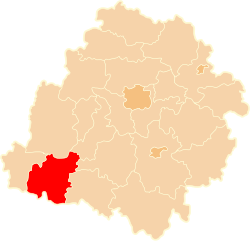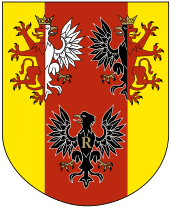Wieluń County
Wieluń County (Polish: powiat wieluński) is a unit of territorial administration and local government (powiat) in Łódź Voivodeship, central Poland. It came into being on January 1, 1999, as a result of the Polish local government reforms passed in 1998. Its administrative seat and only town is Wieluń, which lies 88 kilometres (55 mi) south-west of the regional capital Łódź.
Wieluń County Powiat wieluński | |
|---|---|
 Flag  Coat of arms | |
 Location within the voivodeship | |
| Coordinates (Wieluń): 51°13′21″N 18°34′26″E | |
| Country | |
| Voivodeship | Łódź |
| Seat | Wieluń |
| Gminas | |
| Area | |
| • Total | 927.69 km2 (358.18 sq mi) |
| Population (2006) | |
| • Total | 78,260 |
| • Density | 84/km2 (220/sq mi) |
| • Urban | 24,347 |
| • Rural | 53,913 |
| Car plates | EWI |
| Website | http://www.powiat.wielun.pl |
The county covers an area of 927.69 square kilometres (358.2 sq mi). As of 2006 its total population is 78,260, out of which the population of Wieluń is 24,347 and the rural population is 53,913.
Neighbouring counties
Wieluń County is bordered by Sieradz County to the north, Łask County to the north-east, Bełchatów County and Pajęczno County to the east, Kłobuck County to the south-east, Olesno County to the south, and Wieruszów County to the west.
Administrative division
The county is subdivided into 10 gminas (one urban-rural and nine rural). These are listed in the following table, in descending order of population.
| Gmina | Type | Area (km²) |
Population (2006) |
Seat |
| Gmina Wieluń | urban-rural | 131.2 | 32,882 | Wieluń |
| Gmina Wierzchlas | rural | 119.2 | 6,651 | Wierzchlas |
| Gmina Pątnów | rural | 114.3 | 6,452 | Pątnów |
| Gmina Biała | rural | 75.0 | 5,503 | Biała |
| Gmina Mokrsko | rural | 77.8 | 5,446 | Mokrsko |
| Gmina Osjaków | rural | 100.7 | 4,780 | Osjaków |
| Gmina Ostrówek | rural | 101.6 | 4,642 | Ostrówek |
| Gmina Czarnożyły | rural | 69.9 | 4,591 | Czarnożyły |
| Gmina Konopnica | rural | 83.1 | 3,897 | Konopnica |
| Gmina Skomlin | rural | 55.0 | 3,416 | Skomlin |
